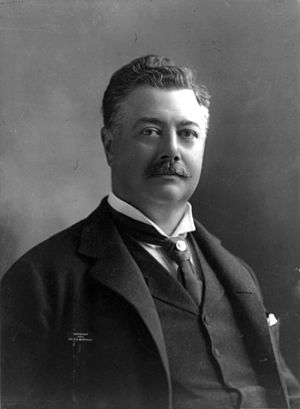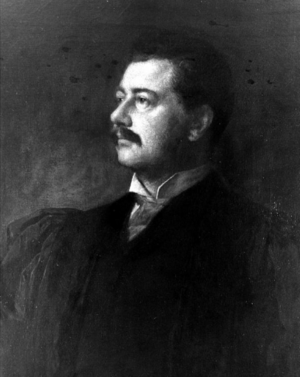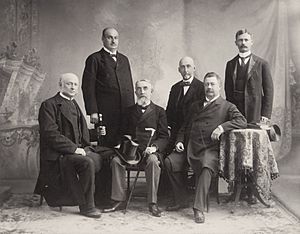Seth Low facts for kids
Quick facts for kids
Seth Low
|
|
|---|---|

Low in 1901
|
|
| 92nd Mayor of New York City | |
| In office January 1, 1902 – December 31, 1903 |
|
| Preceded by | Robert Anderson Van Wyck |
| Succeeded by | George B. McClellan Jr. |
| 11th President of Columbia University | |
| In office 1890–1901 |
|
| Preceded by | Frederick A. P. Barnard |
| Succeeded by | Nicholas Murray Butler |
| 23rd Mayor of Brooklyn | |
| In office January 1, 1881 – December 31, 1885 |
|
| Preceded by | James Howell |
| Succeeded by | Daniel D. Whitney |
| Personal details | |
| Born | January 18, 1850 Brooklyn, New York |
| Died | September 17, 1916 (aged 66) Bedford Hills, New York |
| Cause of death | Cancer |
| Resting place | Green-Wood Cemetery |
| Nationality | American |
| Political party | Republican |
| Spouse | Anne Wroe Scollay Curtis |
| Parents | Abiel Abbot Low and Ellen Almira Dow |
| Alma mater | Columbia College |
Seth Low (18 January 1850 – 17 September 1916) was an important American leader. He was a teacher and a politician. He served as the 23rd Mayor of Brooklyn, the president of Columbia University, and the 92nd Mayor of New York City. He also represented the United States as a diplomat. Low was known for trying to make city governments work better during a time called the Progressive Era.
Contents
Early Life and Family
Seth Low was the son of Abiel Abbot Low and Ellen Almira Dow. His father was a successful businessman who traded with China. Seth's aunt, Harriet Low, was one of the first American women to live in China. The Low family came from old New England families. Seth was named after his grandfather, Seth Low (1782–1853), who helped start the city of Brooklyn. His grandfather also worked to help people in need. On his deathbed, he told young Seth to "Be kind to the poor."
Low attended Poly Prep Country Day School in Brooklyn and then Columbia College. After graduating in 1870, he traveled for a short time. Then, he joined his father's business, A. A. Low & Brothers. He became a partner in 1875 and later left the company with a large amount of money.
On 9 December 1880, Seth Low married Anne Wroe Scollay Curtis. She was the daughter of Justice Benjamin R. Curtis of the U.S. Supreme Court. They did not have their own children but adopted two nieces and a nephew.
Mayor of Brooklyn
First Term as Mayor
By 1881, the city of Brooklyn had been run for many years by a political group known for corruption. This group was led by Hugh McLaughlin. People in Brooklyn wanted better government. They started to support "good government" ideas and were tired of the old way of doing things.
The Republican Party in Brooklyn saw a chance to win. Seth Low was chosen as a candidate because he was wealthy and from an old, respected family. He also believed in reforms. Low agreed to run for mayor, promising to be fair to everyone, not just one political party. He won the election against the current mayor, James Howell.
During his time as mayor, Low made many important changes:
- He helped Brooklyn gain more "home rule." This meant the city could make more of its own decisions instead of the state government telling it what to do.
- Low improved schools. He was the first to integrate Brooklyn schools, meaning students of all backgrounds could attend together. He also made textbooks free for all students. To hire teachers, he started using competitive exams instead of giving jobs to political friends. He also set aside money to build new schools.
- He introduced a Civil Service Code for all city workers. This meant people were hired based on their skills, not because they knew someone important. This helped stop "patronage jobs," which were jobs given as favors.
- Low found a way to let German immigrants enjoy their local beer gardens on Sundays. State laws usually did not allow this. Low said saloons could stay open if they were orderly. If they became too noisy, they would be closed.
- He was on the board of the company that built the Brooklyn Bridge.
Second Term and Beyond
Low's decisions, like raising taxes and trying to be fair to all parties, made some people unhappy. Even though he won re-election in 1883, it was by a much smaller number of votes.
In 1884, Low supported a Democrat, Grover Cleveland, for president. This upset many of his fellow Republicans. He decided not to run for a third term in 1885. Instead, he supported another reform candidate. However, the public's interest in reform had lessened, and a Democrat, Daniel D. Whitney, won the election. This brought back the old political ways for several years. Later, people looked back at Low's time as mayor as a "Golden Age" of honest government.
President of Columbia University

After being mayor of Brooklyn, Seth Low became the president of Columbia College in 1890. He served until 1901. Even though he wasn't a teacher, he was a great leader. He helped move the college from Midtown Manhattan to a new area called Morningside Heights. He also got permission to change its name to "Columbia University." The new campus was designed to be a part of the city.
Low brought different schools within Columbia together into one organization. He also made other changes, like improving the Law School and adding a science department. He helped connect the University with the Teachers College. In 1895, he gave one million dollars of his own money to build the Low Memorial Library on the new campus. It was named after his father and opened in 1897.
International Peace Conference
On July 4, 1899, Seth Low was one of the American representatives at the International Peace Conference in The Hague, a city in the Netherlands. Other important people there included Andrew D. White, the U.S. Ambassador to Germany, and Captain Alfred Mahan of the U.S. Navy.
At the conference, Low gave the final speech. He talked about how the United States and the Netherlands had learned from each other. He mentioned that the U.S. flag first received a foreign salute from a Dutch officer. He also said that the idea of free public schools came to America from the Netherlands. Low spoke about how the United States learned from the Dutch to separate church and state. He thanked the Dutch for their focus on learning, religious freedom, and individual freedom.
Mayor of New York City
Low first ran for mayor of the larger, combined New York City in 1897, but he didn't win. This was partly because the groups who opposed the powerful Tammany Hall political machine were divided. However, four years later, in 1901, he tried again and won.
During his 1901 campaign, the famous writer Mark Twain supported him. They appeared together at an event that drew over 2,000 people.
In 1902, Low left his job as president of Columbia University to become the second mayor of the newly combined City of New York. He was the first mayor of Greater New York to be elected with support from both the Citizens Union and the Republican parties. Some of his important achievements as mayor include:
- Starting a civil service system based on merit for hiring city workers. This meant people got jobs because they were good at them, not because of political connections.
- Reducing "graft," which is a type of corruption, within the police department.
- Improving the education system in the city.
- Lowering taxes.
Even with these achievements, he only served for two years. He was defeated in 1903 by Democrat George B. McClellan Jr..
Later Life and Legacy
After being mayor, Seth Low continued to be involved in public service. From 1907 to 1916, he was the chairman of Tuskegee University, a college for African American students led by Booker T. Washington. Also from 1907, he was president of the National Civic Federation, a group that worked with both businesses and labor unions. He believed that workers had the right to negotiate for better conditions. He preferred solving problems through discussion and agreement, rather than strikes.
Low also helped start the Bureau of Charities of Brooklyn. He was vice-president of the New York Academy of Sciences and president of the Archaeological Institute of America.
He became interested in how to make food more affordable. He believed that farmers and consumers working together could help. He was president of the Bedford Farmers' Cooperative Association. He also helped start the Cooperative Wholesale Corporation of New York City. Low was also a trustee of the Carnegie Institute in Washington, D.C.
In the spring of 1916, Seth Low became ill with cancer. He passed away at his home in Bedford Hills, New York, on 17 September 1916. His funeral showed how well he could bring people together. Important people from both business, like J. P. Morgan Jr., and labor, like AFL founder Samuel Gompers, were honorary pallbearers.
He is buried in Green-Wood Cemetery in Brooklyn, New York.
Several places are named after Seth Low:
- The Brooklyn Fire Department had a fireboat named Seth Low from 1885 to 1917.
- There is a playground named after Low in the Bensonhurst neighborhood of Brooklyn.
- In Seth Low Pierrepont State Park Reserve, there is a street called Seth Low Mountain Road.
- Intermediate School 96 in Bensonhurst, Brooklyn, is known as Seth Low Intermediate School 96.
- In the Brownsville section of Brooklyn, there is a public housing development called Seth Low Houses.
- There was a Seth Low Junior College at Columbia University from 1928 to 1936.


